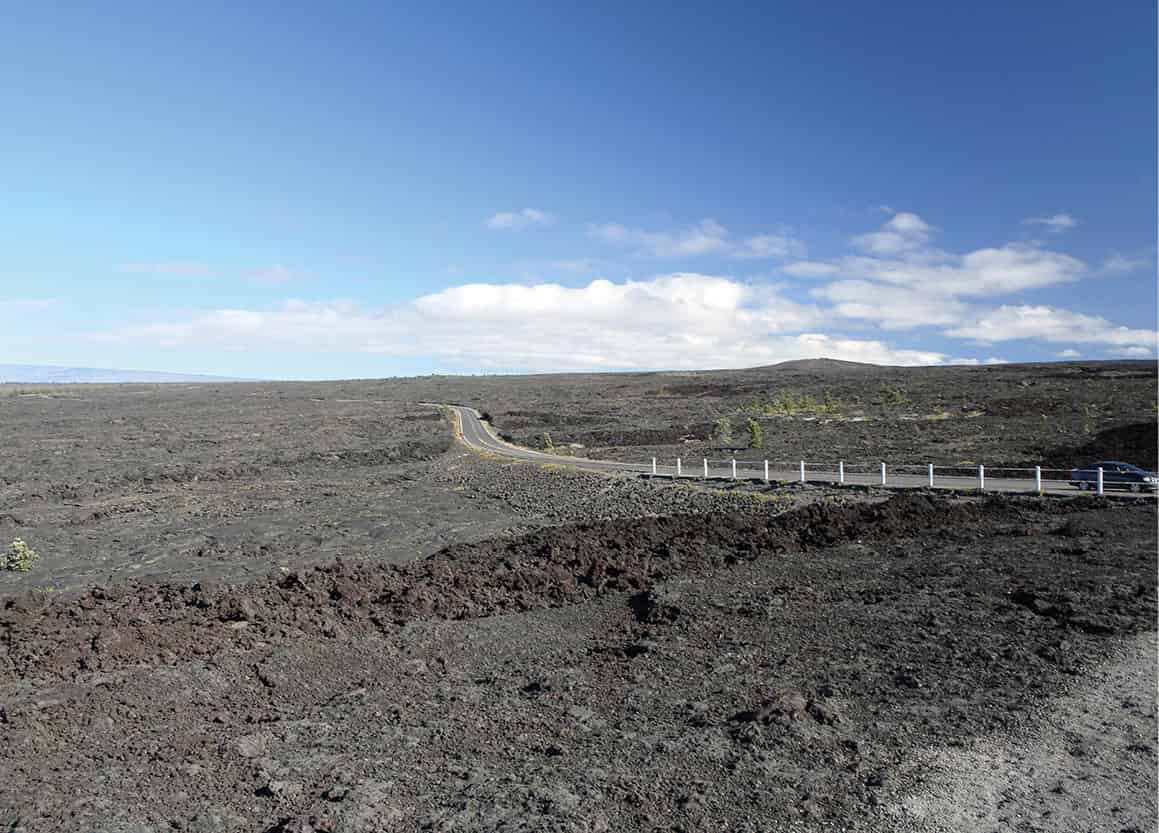DISTANCE: 40 miles (64km)
TIME: A full day or more
START: Hawai‘i Volcanoes National Park Visitor Center
END: Volcano Village
POINTS TO NOTE: The weather can be a bit cool at the top of the park, but layers of clothing are the best solution – the coastline, which can bring you much nearer to flowing lava, is as hot as you’d expect it to be. Covered shoes are a must. Although you can push for half a day, this option really deserves a full day, better yet, two. This tour is suitable for children − it’s a wonderful park for all ages. If you wish to take your time exploring, a stay in Hilo or Volcano Village is a good option.
First things first – to truly understand the geological force you’re standing upon, start at the Hawai‘i Volcanoes National Park Visitor Center 1 [map]. Not only will you learn about the volcano, you’ll also get information you need on road closures and volcanic activity information. Ask the staff if you can view the flowing lava along the coast today – and heed their advice.
Kilauea
The park celebrated its 100th birthday in 2016. Across the road from the visitor center is Volcano House 2 [map], a hotel and restaurant perched on the very rim of Kilauea Caldera 3 [map]. All of the current volcanic activity is from Kilauea, which is the longest continuously erupting volcano in the world. Volcano House’s location is superb, and its caldera lookout is a must; varying hues of lava on the caldera bottom betray multiple lava flows between 1885 and 1982. The rooms are comfortable, though basic, and the hotel dining room offers decent fare for dinner. Cross the road to the Volcano Art Center 4 [map], next to the visitor center. Volcano is rich in creative talent, and the center’s offerings are perhaps some of the best in the islands.

Gas and smoke rise from Halema’uma’u Crater
Steven Greaves/Apa Publications
This is the realm of Pele, the volcano goddess. From the visitor center, follow Crater Rim Drive. A few minutes past Steaming Bluff, where seeping groundwater hits hot rock. Drive across a 1974 lava flow to the Halema’uma’u Lookout 5 [map]. The short path is sometimes veiled in smelly vapors; note the signs and health warnings. Halema’uma’u, a collapsed crater within Kilauea Caldera, is said to be the current abode of Pele. Believers leave gifts of ti leaves, coins and flower leis on the rim. It’s considered very bad luck to take lava rock to the island – the visitor’s center features letters of those that have sent it back.

Chain of Craters Road
Steven Greaves/Apa Publications

Lava field
Getty Images
Loihi
Turn off on to the Chain of Craters Road, which descends down Kilauea’s East Rift (which itself descends into the ocean). A new island-to-be, Loihi, gestates 3,000ft (9l5 meters) below the surface on the east rift and is probably 100,000 years from reaching the surface. Once it was possible to loop around to Hilo this back way through the village of Kalapana, but Pele, ever a force to be reckoned with hereabouts, changed all that when flowing lava destroyed the town and road.
Viewing lava
When lava flows hit the ocean, spiraling clouds of steam rise furiously hundreds of feet into the air. Twilight turns the coast into a surreal red perdition, strangely beautiful. Check with the visitor center about hiking out – if they say it’s a go, do so in the evening for the best viewing. Returning to the Rim road, drive past the Kilauea Iki Crater. In 1959, a 2,000ft (610-meter) -high erupting fountain issued skyward from here. The Devastation Trail 6 [map] is a somber meditation, countered by a rainforest walk to, and through, the Thurston Lava Tube. Other surprises demand your time: Pua’ulu (Bird Park), the Tree Molds and the Mauna Iki Footprints. As Kamehameha I was consolidating his rule over the Big Island, some fleeing warriors died on the Ka’u Desert from Kilauea’s toxic gases and ash. Their footprints solidified in the ash. It’s an easy trail, one of many that slice throughout the park.

Thurston Lava Tube
Shutterstock
Food and drink
Volcano Village is just minutes from the park entrance. A lot of artists have gravitated to this 3,700-ft elevation (1,128-meter) community, which is a quiet, reflective place. The best food can be found at Café Ohia, see 1, Volcano House, see 2 or the Kilauea Lodge, see 3. Several excellent bed-and-breakfast options are also in the area.
Food and Drink
1 Café Ohia
19-4005 Haunani Road, Volcano; tel: 808-985 8587; www.cafeohia.blogspot.com; daily 6am−7pm; $
This is a cute little shop with outdoor picnic table seating only. Maybe not for the committed carnivore, but not vegetarian either. Try the daily special – they know what they’re doing!
2 Volcano House
Crater Rim Drive; tel: 808-756 9625; www.hawaiivolcanohouse.com/dining; 7am–10am, 11am–2pm and 5.30–9pm; $$
This place overlooks Kilauea Crater and serves dishes made from locally sourced meats, fruit and veggies, making for wonderful, hearty meals.
3 Kilauea Lodge
19-3948 Old Volcano Road, Volcano; tel: 808-967 7366; www.kilauealodge.com; 7.30am–2pm, dinner from 5pm, Sunday Brunch 10am–2pm; $$$–$$$$
This place has a cozy, mountain-cabin feel, and a full range of dishes − from comfort food to fine dining – to delight every guest.
